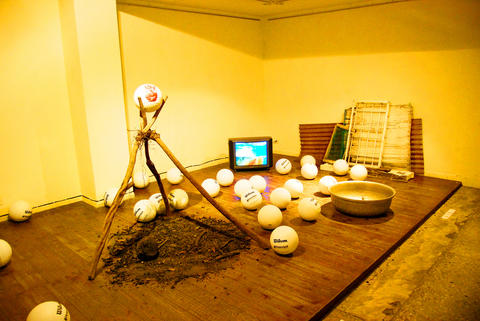It's the end of the year and the Taipei Times looks back at some great art moments and peers into its crystal ball to predict five up-and-coming artists/trends to watch out for. In keeping with the festive season, we'll count down like it's New Year's Eve:
5. Tseng Yu-chin (曾御欽) had his video work displayed at Germany's prestigious Documenta exhibition this summer. What was noteworthy was that he was not filling any quotas or participating in a national presentation. Rather he was included because he's an exceptional artist ready to participate at an international level. He recently embarked on a six-month art residency in New York.
4. Sean Hu Chao-sheng (胡朝聖). Okay, he's not an artist. He's a curator. His first experience was with land art and he's curated some notable exhibitions this year such as Lin Chuan-Chu's (林銓居) rice field/painting studio in Dazhi, Fashion Accidentally at Taipei MOCA and Very Fun Park in Taipei's East District (東區). What is remarkable about Hu's curatorship is his inclusiveness. He does not only invite ethnic Taiwanese for his exhibitions, which most Taiwanese curators tend to do, he includes artists and designers from various ethnicities, gender identifications and art practices to participate. Other curators, should take note.

PHOTO: SUSAN KENDZULAK
3. One of the best works created this year was by Yao Jui-chung (姚瑞中). Yao is no novice as he's already exhibited at the Venice Biennale, plus numerous other exhibitions. He's also known for curating shows and having authored several books. But the video he made where he's slowly goose-stepping about the CKS Statue Park in Tashi (大溪) Township, Taoyuan County, hits the bull's-eye. In this age of "desinicization," Yao's mockery of statues and idols is timely, comical and a tad visionary.
2. Number two is not an artist, nor a curator, but rather the notable status of the equality of women in Taiwan's art institutions: Lin Mun-lee (林曼麗) is director of the National Palace Museum; Lai Hsiang-ling (賴香伶) is coming to the end of her two-year contract with Taipei MOCA; Hsieh Hsiou-yun (謝小韞) is director of the Taipei Fine Arts Museum and Ava Hsueh (薛保瑕) is director of the National Taiwan Museum in Taichung.
1. Hands down! Our big winner for the year, undoubtedly, is Kuo I-chen (郭奕臣). Kuo seamlessly merges high-tech gadgetry with profound metaphysical concerns making him stand apart in Taiwan's contemporary art scene. He got off to a running start by first exhibiting at 2004's Taipei Biennial, when he was just a student, well, a grad student. This summer his participation in Thermocline: New Asian Waves at ZKM in Karlsruhe, Germany, brought him acclaim. The Centre Pompidou has bought his work for its collection. In October, he had four simultaneous exhibitions that featured work showing a destroyed earth but which demonstrated humanity's hope for survival. Meanwhile, international curators are flocking to his studio. The art world will have to wait, however, as Kuo just started his military service.

June 9 to June 15 A photo of two men riding trendy high-wheel Penny-Farthing bicycles past a Qing Dynasty gate aptly captures the essence of Taipei in 1897 — a newly colonized city on the cusp of great change. The Japanese began making significant modifications to the cityscape in 1899, tearing down Qing-era structures, widening boulevards and installing Western-style infrastructure and buildings. The photographer, Minosuke Imamura, only spent a year in Taiwan as a cartographer for the governor-general’s office, but he left behind a treasure trove of 130 images showing life at the onset of Japanese rule, spanning July 1897 to

One of the most important gripes that Taiwanese have about the Democratic Progressive Party (DPP) is that it has failed to deliver concretely on higher wages, housing prices and other bread-and-butter issues. The parallel complaint is that the DPP cares only about glamor issues, such as removing markers of Chinese Nationalist Party (KMT) colonialism by renaming them, or what the KMT codes as “de-Sinification.” Once again, as a critical election looms, the DPP is presenting evidence for that charge. The KMT was quick to jump on the recent proposal of the Ministry of the Interior (MOI) to rename roads that symbolize

On the evening of June 1, Control Yuan Secretary-General Lee Chun-yi (李俊俋) apologized and resigned in disgrace. His crime was instructing his driver to use a Control Yuan vehicle to transport his dog to a pet grooming salon. The Control Yuan is the government branch that investigates, audits and impeaches government officials for, among other things, misuse of government funds, so his misuse of a government vehicle was highly inappropriate. If this story were told to anyone living in the golden era of swaggering gangsters, flashy nouveau riche businessmen, and corrupt “black gold” politics of the 1980s and 1990s, they would have laughed.

In an interview posted online by United Daily News (UDN) on May 26, current Chinese Nationalist Party (KMT) Chairman Eric Chu (朱立倫) was asked about Taichung Mayor Lu Shiow-yen (盧秀燕) replacing him as party chair. Though not yet officially running, by the customs of Taiwan politics, Lu has been signalling she is both running for party chair and to be the party’s 2028 presidential candidate. She told an international media outlet that she was considering a run. She also gave a speech in Keelung on national priorities and foreign affairs. For details, see the May 23 edition of this column,